
Treating Burns Page Selection Menu: 1 2 3 4 5 6 7 8 9 10 Next>>
Treating Burns During the Golden Age of Piracy, Page 5
Burn Treatment Theory - Burns By Degree
"Furthermore Combustions doth speedily require a Surgeon, and let him inquire

Author William Fabry
aka Guilelmus Fabricius Hildanus
to what Species it is to be referred." (Guliielm. Fabricius Hildanus, His Experiments in Chyrurgerie, p. 8)
Although not widely repeated in period surgical manuals, which are mostly focused upon treatment based on visual cues rather than any theoretical division of burn types, William Fabry aka. Guilelmus Fabricius Hildanus, divided burns into three distinct types in his book in the early 17th century.
His reason for doing this was to make sure treatment was "rightly instituted, [so] we will divide all Combustions of what fiery matter soever they are made, into 3. Divisions, to wit, into a Small, Indifferent [medium], and Great"1.
While the fine points of various burn degrees that Fabry defines are somewhat different than the degrees of burn severity that are used in medicine today, the overall concept is remarkably similar. And even though his contemporary period surgeons don't refer directly to Fabry's method, they do sometimes classify different burns by their severity in a similar manner, so the theory is worth examining.
1 Guliielm. Fabricius Hildanus, His Experiments in Chyrurgerie, p. 3
Burn Treatment Theory - 1st Degree Burns
Fabry begins all his descriptions of the different degrees of burns by explaining how each type of wound was received. For first degree burns, he notes that "the thing which burneth doeth not long stick unto the body, or be but light as straw, flax, hemp, or any kind of light or dry wood, or any thing which quickly falleth off"1. He expands on this, noting that "the firy substance was gentle, as Straw, Flax, Hempe, and the like; or that [it] did fall off, as hot water: or that the part touched it but a little moment of time"2.
Such glancing burns resulted in a "rednesse of the skin, a sharp and pricking pain, like as though the skin were rubbed with Nettle-seed; by and by (except there be fit remedies applyed) the place is inflamed, and pustles
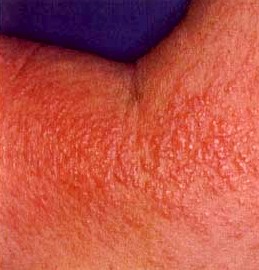
Photo: DJ Elpern
1st Degree Burn with Minor Blistering
[blisters] doe arise, in the which is contained cleere and white water, as also the upper skin is separated"3.
When dealing with 1st degree burns, Fabry advises the surgeon to "prevent the rising of pustels [blisters]; for if he can do that the Patient need not feare any further molestation"4. After that, he suggests applying hot liquids, reasoning that "outward heat doth draw unto it Empyruma [empyreuma], that is, heat left by the fire in the burned part, as Aristotle and experience teacheth; for as a Scorpion being applied to the bit of a Scorpion doth draw to it his proper poison; so doth heate draw heat"5. Following the drawing of heat with heat, he suggests applying oily concoctions and onions - the details of which we'll examine in greater detail when we discuss medicines. These would tend to protect the wound from the air and perhaps mitigate the pain.
John Moyle likewise explains that when a burn is "Superficial then blisters and Fiery heat in sues."6 While not identifying the specific treatments for first degree burns, Moyle broadly advises the surgeon to use a similar procedure to that specified by Fabry. "You have at first here a Two-fold Scope; that is, to Mitigate the Pain, and fetch out the Burning"7. The concept of separating pain from the removal of the burning sensation from a burn may seem sort of odd to us, but it is based on the classical teachings about medicines which will be discussed further in the next section.
1 Guliielm. Fabricius Hildanus aka William Fabry, His Experiments in Chyrurgerie, p. 4; 2 Hildanus, p. 7; 3 Hildanus, ibid.; 4 Hildanus, p. 20; 5 Hildanus, ibid.; 6 John Moyle, The Sea Chirurgeon, p. 97; 7 Moyle,ibid.;
Burn Treatment Theory - 2nd Degree Burns
Fabry
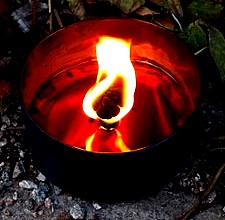
Photo: Wiki User Ojan
A Pitch Burning Lamp
states that second degree burns are caused by agents which "longer stick, or [are] induced with a more violent heat"1. In this case, "the firy substance did touch the [body] part a longer time, or it retained some greater heat in it, as hot iron, or any liquid mettle, hard wood, Pitch, Oyle, Wax, and the like"2.
Fabry describes the resulting burn wound which "doth presently inflame, waxeth red, painfull and burneth, and in the very same moment pustels are elevated, in which are contained thin water, and waxeth yellow and is sore by reason of the stretching of the skin, which is stretched and drawne together by the stanch of the fire."3 This results in the dry condition he mentioned when describing first degrees burns. This occurs because "the true skin is made destitute of Radicall moisture from the part, and it is something dryed and drawn together, but not as yet any Escar made."4 An escar in this description is the scab that forms over a burn.
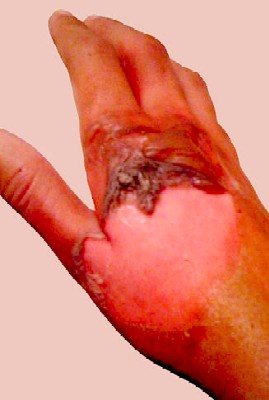
Photo: Wiki User Jmh649
Major 2nd Degree Burn of the Hand
The procedure that Fabry suggests is to cut open the blisters and allow them to drain as in the case of first degree burns. After that, he explains that since "humours and blood doe presently flow to the affected place, it is needful to prevent them with defensives [protective medicines that will keep the 'bad' humors out]... [by applying medicine that is] about the breadth of the palme of ones hand upon the burnt place"5. Next, the burned area is bandaged with "rowlers modified in water and Vinegar... for by this meanes the humours are repressed"6 and kept from gathering at the burn site.
Fabry notes that some surgeons "apply drying Medicines, as Unguent ex calco tota Diapompholigos Album Rasis. [an unguent made from nightshade, wax and other ingredients] and the like, but because such drying Medicines doe contract the skinne, and cause filthy skarres, I doe not allow of the use of them"7. He instead prefers emollients, or moisturizing medicines be applied until "the end of the Cure."8
Sea surgeon John Moyle likewise recommends dressing burn wounds the day after they are received, "the sooner to bring them to digestion [causing a wound to form new flesh]"9
Naval surgeon John Atkins adds some medicinal treatments to the cure of 2nd and 3rd degree burns, explaining that "the Intentions of Cure are, alleviating the painful Sense of Cutis, Digesting and Cicatrizing [healing over with a scab]."10 These procedures do not contradict Fabry's recommendations for the most part, although healing over with a scab would most likely create a 'filthy skarre.'
1 Guliielm. Fabricius Hildanus aka William Fabry, His Experiments in Chyrurgerie, p. 4; 2 Hildanus, p. 7-8; 3 Hildanus, p. 8; 4 Hildanus, p. 4; 5 Hildanus, p. 27; 6 Hildanus, p. 29; 7 Hildanus, ibid.; 8 Hildanus, ibid.; 10 John Atkins, The Navy Surgeon, p. 176; 10 John Moyle, The Sea Chirurgeon, p. 56
Burn Treatment Theory - 3rd Degree Burns
Please note that the images in this section are quite graphic.
William Fabry explains that third degree burns are the most troublesome, caused when "the fiery matter do stick very long, and doth contain in it a most violent heat"1.
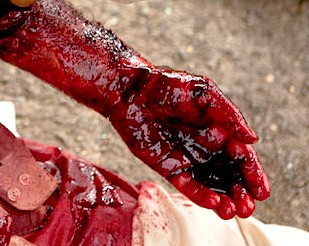
Photo: US Marines
Simulated 3rd Degree Burn of the Arm and Hand
As a result "the flesh, veins, arteries, Nerves &c. are burned, drawn together, and dryed into an Eskar [scab of burned skin], because the naturall moysture is consumed, with the strength of the fire"2. Fabry goes on to explain that "there are pustels elevated, but presently they fall again, and chiefly in the same place where the Combustion is great and vehement, and the under skinne seemeth blacke and wane, and hardly feeleth, though it bee pricked with a Lancet, for there is a hard and dry crust, which when it falleth off, there remaineth a deep and profound Ulcer, from the nature of the firy matter, and the space how long it hath stucke unto the body, a great Combustion may be knowne."3
Sea surgeon John Moyle similarly says that he has "seen some [wound sites] so burnt that the very Nerves and Tendons have shrunk, causing grievous Inflammation, dolor and other Symptomes... [where] the moisture of that part is dried up, and causeth an Escar"4.

Photo: Wiki User Drgnu23
Gangrene in the 4th Toe of a Man's Foot
Fabry warns that a third degree burn is
very dangerous, for that very often it ingendreth Gangrena and Sphacetus [gangrene and sphacelus]; For first by reason of the vehement heat, the Radicall moisture and naturall heat is dryed up. Secondly, the skin Musculous, Flesh, Veynes, Arteries &c. be dried and drawn together, so that the blood cannot flow to the offended parts. Thirdly, the Humours and blood, by reason of the Solution of Continuitie and paine doe gather together, and increase the Burning heat, hereby by reason of the want of nourishment, and choaking of the naturall heat, the affected part mortifieth5.
As a result of this tendency, he advises that third degree burns "ought to be carefully and judiciously handled, and alwayes something [medicinal] ought to be applied, which may resist corruption."6
For the cure of a third degree burn, any blisters are once again to be cut open so that the 'bad' humors can escape and then "dryed with a clout or sponge; then the Escarre [burned skin or scab] is to be
separated, or at least to be cut away almost as close as the flesh, whereby the humour which is retained
under the hard crust may flow forth, the Medicines may enter, and whatsoever is inducerated and hardned by reason of the heat may softened; the Escarre ought to be separated the first or second day 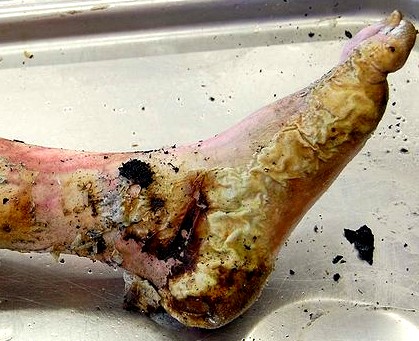
Photo: Wiki user Goga312
3rd Degree Burn to the Foot with Tissue Charring Requiring Debridement
before the part be inflamed"7.
Today, the process of removing dead or damaged skin is called debridement, a process that is still used in severe burn cases. We will look at debridement in greater detail in the following pages.
For medicinal treatment of 3rd Degree burns, Fabry starts with defensive medicines followed by "Rowlers wet in water and vinegar, that the violent flux of humours may be stayed"8. He warns not to use defensives when "the Veynes, [and] Arteries, are contracted by the fire ...except they [that] have some power to resolve [reduce inflammation], viz. such as are these, Beane Flower, Flower of Lupins, of wheat, and the powder of Camomile Flower"9.
Fabry also advises purging, bleeding and cupping to further dissipate the 'bad' humors as was discussed previously. "When the Flowing of Humours and blood is stayed, then Defensives are left off, whereby the spirits and nutriment may the better passe to the affected part, and to divide and separate the Escarre: Wherefore the learned Chirurgion which is the Hand-maid of Nature, ought every day, as much as possibly he can, without paine to separate some of the Escarre"10.
1 Guliielm. Fabricius Hildanus aka William Fabry, His Experiments in Chyrurgerie, p. 4; 2 Hildanus, ibid.; 3 Hildanus, p. 8; 4 John Moyle, The Sea Chirurgeon, p. 96; 5 Hildanus, p. 31-2; 6 Hildanus, p. 34; 7 Hildanus, p. 32; 8 Hildanus, p. 33; 8 Hildanus, ibid.; 8 Hildanus, p. 33-4

